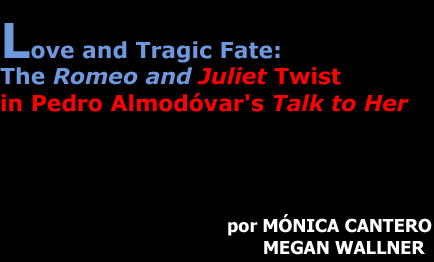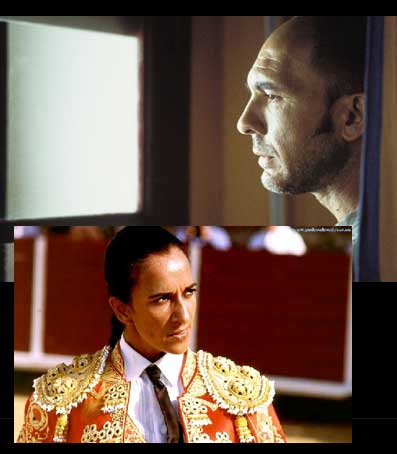

There is not such a satisfying ending to the real story of Romeo and Juliet. The “star-crossed”, or fated, lovers both come to their demise at the end of the play—leaving their families to reflect what their hatred has done. Fate is important in the beginning of the play, when the two first meet and fall in love. The irony of their love is that they each die because they cannot live without one another, although each is truly alive when the decision is made. This is one of the largest similarities between Romeo and Benigno, each stopping their own lives because they cannot live without the women they love.
The similarities between the characters of Romeo and Benigno are not the only character connections that exist between Talk to Her and Romeo and Juliet . Alicia is the Juliet figure, especially because her father attempts to ensure her and Benigno do not have more than a nurse to patient relationship. This is similar to Juliet's father who wanted to guarantee Juliet would marry someone who would benefit the family's status. Both Romeo and Juliet have figures that nurture and protect them in the play; Juliet's being the nurse and the Friar watches after both of the protagonists. In Talk to Her the nurse plays a critical role in Juliet's growth and development. She is a person for Juliet to confide in and love. Similarly, Katerina is a character of Almodóvar's film who watches after Alicia in her coma and after because she had such a close relationship before, almost thinking of her as a daughter. She is cautious of Alicia speaking to Marco after waking, just as the nurse was worrisome when it concerned males seeking a relationship with Juliet. A very important character in Talk to Her was that of Marcos. Just as caring as Katerina, he is someone for Benigno to confide in. Benigno and Marco have experienced similar tragedies in living with women who are in a coma, and their experiences are paralleled throughout the movie, although Benigno acts differently to Marco with the woman he loves. Almodóvar makes this very clear to the viewer when Marco visits Benigno in jail. The camera shots are framed in a position where the reflection of each character is superimposed over the character that is actually in the camera's view. This is symbolic of the bond between the two characters. Another scene where this link is displayed is when Benigno confesses his true love for Alicia.
Benigno: I wanted to talk to you about that before you leave.
Marco: About what?
Benigno: Loneliness. I want to get married.
Marco: Married? Who to?
Benigno: To Alicia, of course!
Marco: You're crazy!
Benigno: We get along better than most married couples. Why shouldn't a man want to marry the woman he loves?
Marco: Because the woman is in a coma! Because Alicia can't say with any part of her body: ‘I do!'. Because we don't know if vegetative life is really life!
Marco attempts to talk some sense into Benigno, but isn't surprised by his comment. He understands Benigno as a human being and realizes he is innocent—believing himself to be in honest and true love. Benigno's life is empty without Alicia, and Marco knows that. The Friar in Romeo and Juliet does just that, allowing the two lovers to be together although it may be foolish. He even arranges the meeting which ends in both of the lovers' deaths.

These character parallels are consistent throughout both works, but an additional comparison which is steady as well can be observed in the opening and closing of each piece. The chorus in Romeo and Juliet presents the play and the problems to come to the audience. The chorus continues the narration of the play throughout and always allows the audience insight as to what is occurring in the play. Almodóvar replicates this with dance sequences opening and closing Talk to Her . The opening scene is of women running blindly across the stage, incapable of protecting themselves from chairs and other objects strewn about. A man rushes to save the women by pushing the obstructions to the side. The man is obviously putting a lot of energy into his pursuit of protecting the women, while the women are in an entirely different world—never even acknowledging his existence. This is a direct parallel to Benigno, devoting all of his life to care for the woman he loves who is not in tune with the real world.

